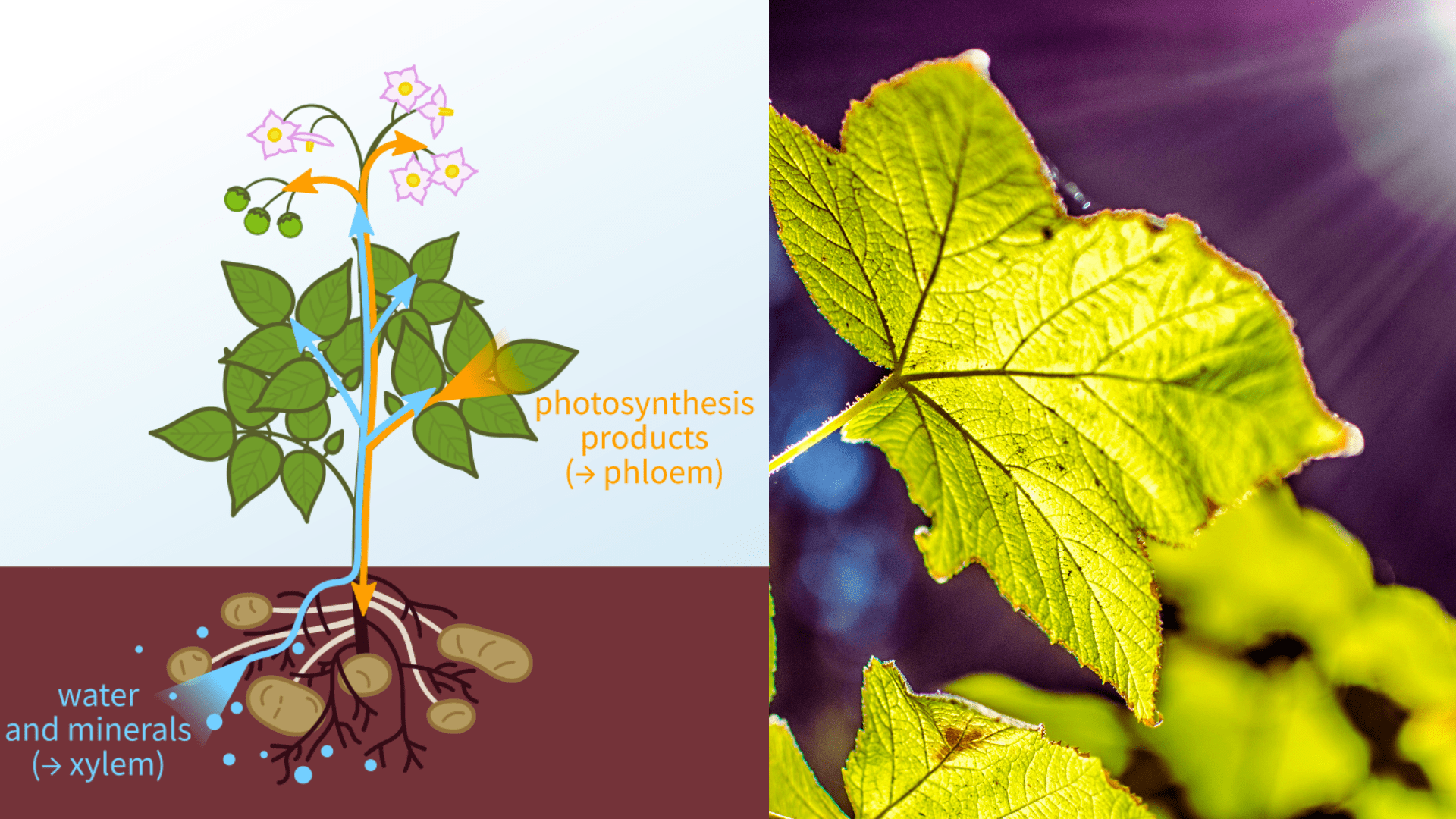The primary function of the phloem is the transport of sugars and other metabolic products photosynthesized in the leaves to various parts of the plant. This includes movement from the leaves (where photosynthesis occurs) to non-photosynthetic parts such as roots, stems, and developing organs. Phloem is a crucial component of the plant’s vascular system, enabling not only nutrition distribution but also the transport of hormonal signals and other substances that influence growth and response to environmental conditions.
The phloem tissue primarily consists of sieve tubes, companion cells, phloem parenchyma, and phloem fibers, each playing a vital role in the transport mechanism known as translocation. This system allows for the efficient distribution of nutrients from ‘source’ regions (high carbohydrate concentration) to ‘sink’ regions (where carbohydrates are utilized or stored) within the plant.
The Structure of Phloem
Different Parts of Phloem
Sieve Tubes
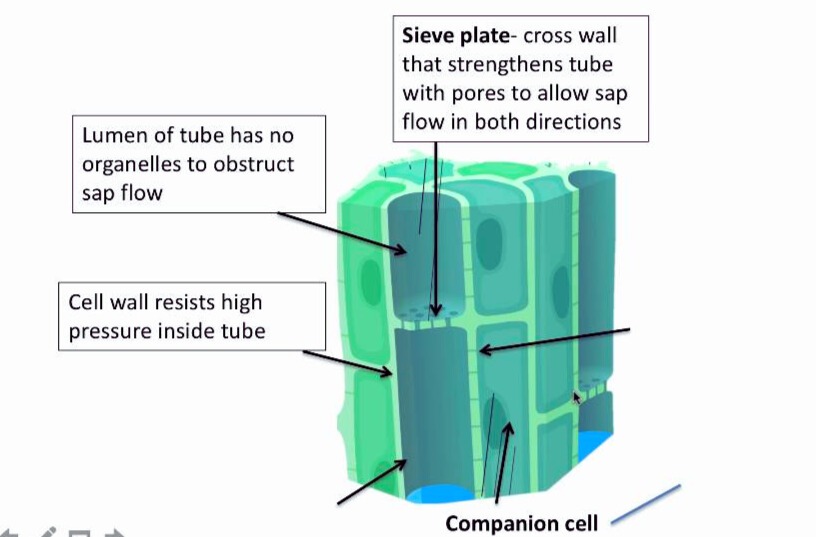
Sieve tubes are a critical component of the phloem, the vascular tissue in plants responsible for transporting nutrients. Structurally, sieve tubes are columns of specialized cells called sieve tube elements. These elements align end to end to form a continuous conduit throughout the plant.
The ends of sieve tube elements are perforated by sieve plates, which are porous barriers that allow the flow of sap between elements. This design facilitates the efficient movement of photosynthetic products, mainly sugars, from the leaves where they are produced to other parts of the plant for storage or growth.
The functionality of sieve tubes is supported by companion cells, which are closely associated with the sieve elements. Companion cells play a vital role in loading and unloading the sugar into the sieve tubes, maintaining the pressure gradient necessary for the flow of nutrients.
Overall, the structure of sieve tubes is adapted to their function of pressure-driven transport of solutes across the plant, a process essential for plant growth and survival.
Companion Cells
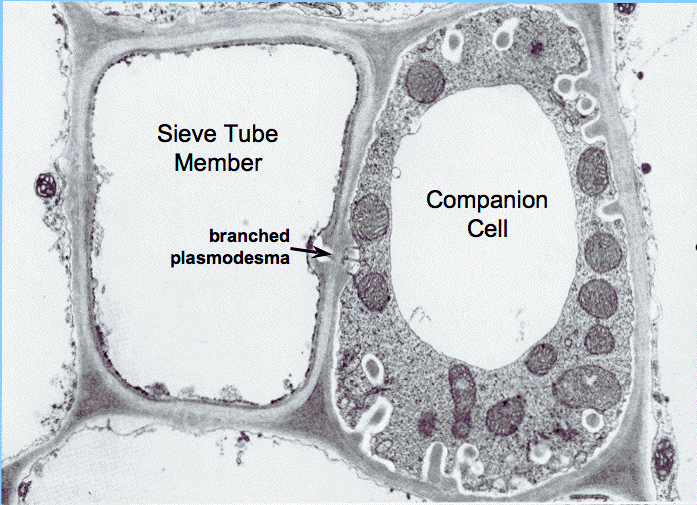
Companion cells are integral components of the phloem, the vascular tissue in plants responsible for transporting organic nutrients, primarily sucrose, from the leaves where they are synthesized to other parts of the plant. These cells are closely associated with sieve tube elements, helping to maintain the function and health of these crucial transport cells.
Companion cells are characterized by their dense cytoplasm which contains all the typical organelles of plant cells, including numerous mitochondria, a well-developed Golgi apparatus, and many ribosomes. Their primary function is to manage the loading and unloading of sugars into the sieve tubes, a critical process for the movement of photosynthates throughout the plant.
This process can occur via different mechanisms, such as apoplast loading where sugars are transported out of the photosynthetic cells into the apoplast before being loaded into the phloem. Alternatively, some plants use a mechanism known as polymer trapping.
In summary, companion cells play a crucial role in the life of plants by ensuring efficient nutrient distribution necessary for various physiological processes, including growth and reproduction.
Phloem Fibers
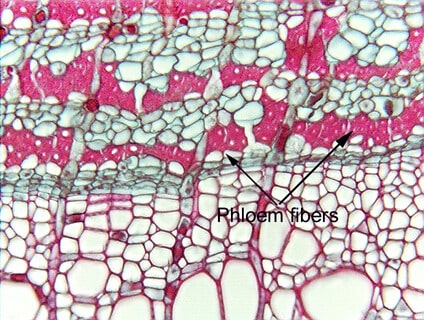
Phloem fibers, also known as bast fibers, are specialized sclerenchyma cells that provide mechanical support and strength to plants. These fibers are long, narrow, and highly elongated, typically found in the phloem, which is part of the plant’s vascular system responsible for transporting organic nutrients. Phloem fibers are particularly notable for their high tensile strength and flexibility, which make them commercially valuable, especially in the production of natural fibers like flax and hemp.
Phloem fibers contribute significantly to the structural integrity of plants by supporting the conductive cells of the phloem and ensuring the stability of the plant’s stem and other structures. They can be found in both primary and secondary phloem, but are typically absent in the metaphloem.
Phloem Parenchyma
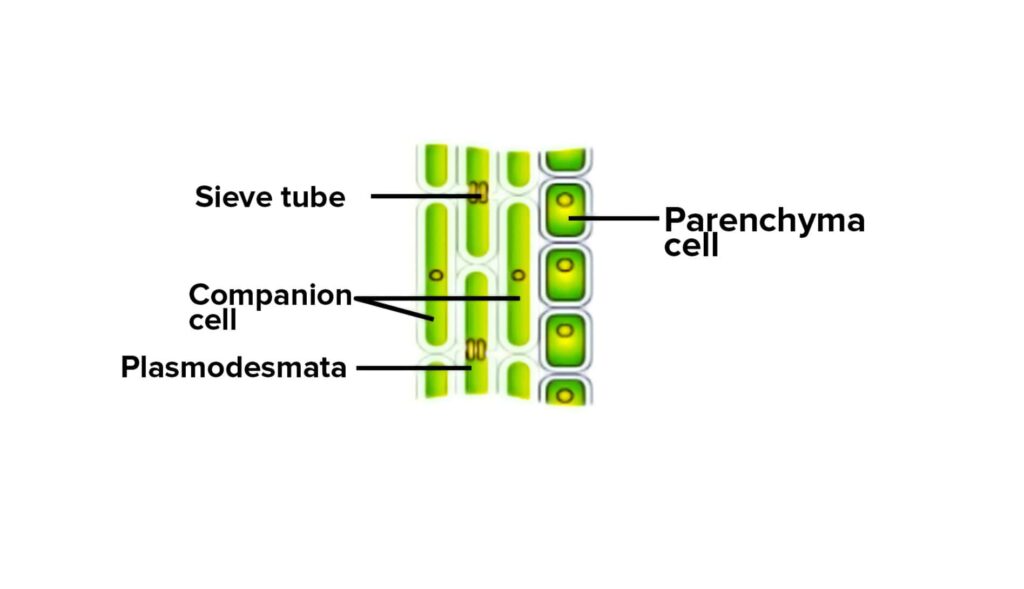
Phloem parenchyma refers to a type of plant tissue found within the phloem, one of the two types of vascular tissue in plants. This tissue serves multiple functions including storage of organic nutrients and contributing to the healing and repair process in plants. Phloem parenchyma cells are living cells that store food and help in the lateral transport of nutrients and water.
These cells are typically more flexible and less rigid than other phloem cells, allowing for the accommodation of changes within the phloem during the plant’s growth and development. Additionally, phloem parenchyma often contains plastids for storing starch and can play a significant role in the synthesis and storage of various other compounds. The specific roles and characteristics can vary significantly among different plant species.
Primary Functions of Phloem
Transport of Sugars
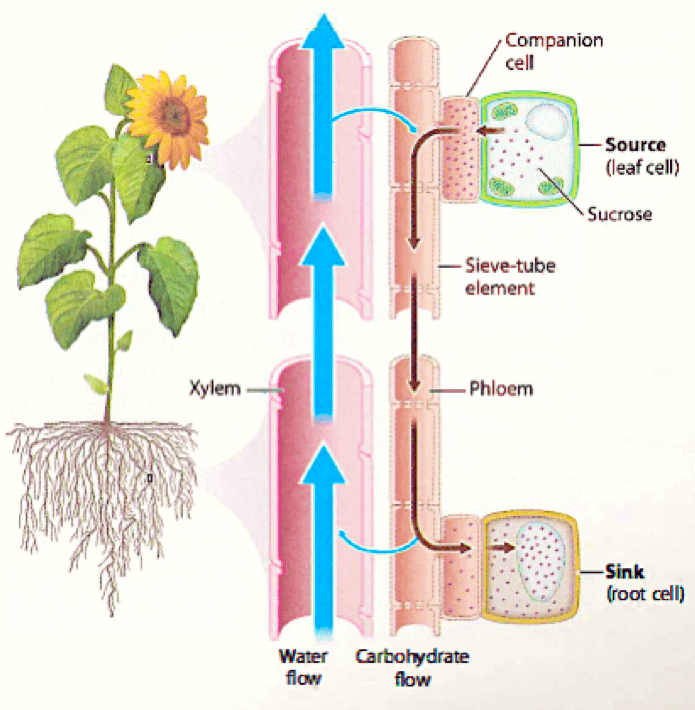
The primary function of phloem in vascular plants is the transport of sugars and other metabolic products from the leaves, where they are synthesized during photosynthesis, to other parts of the plant. This process is crucial for distributing essential nutrients to growing tissues and for storage in roots, seeds, and fruits.
Phloem consists of sieve-tube elements and companion cells. Sugars, primarily sucrose, are actively transported into the phloem’s sieve-tube elements from the photosynthetic cells. This loading of sugars creates a high osmotic pressure, causing water to enter the phloem from the xylem, generating a flow from source regions (like leaves) to sink areas (such as roots and fruits) where sugars are consumed or stored.
Hormonal Transport
Apart from transporting sugars, the phloem also plays a crucial role in the transport of hormones within plants. Hormones are chemical signals that regulate plant growth, development, and responses to environmental stimuli. These are transported through the phloem alongside sugars, proteins, and RNAs, ensuring they reach various parts of the plant where they exert their effects. This hormonal distribution is essential for processes such as tissue differentiation, flowering, and stress response.
How Phloem Transport Works
The Process of Translocation
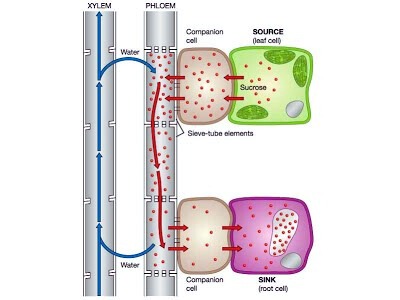
Translocation in plants refers to the movement of organic compounds, primarily sugars like glucose and amino acids, from the leaves (where they are synthesized) to other parts of the plant that cannot produce these substances. This process is essential for distributing energy and nutrients to growing and storage tissues.
The mechanism involves:
- Loading of Sugars: Sugars produced by photosynthesis in the leaves are actively transported into the phloem sieve tubes, a process facilitated by companion cells.
- Water Influx: This loading of sugars into the phloem increases the osmotic pressure within the sieve tubes, drawing water into them from the xylem, which increases the hydrostatic pressure in the phloem at the source (leaves).
- Movement to Sinks: The high hydrostatic pressure drives the phloem sap containing the sugars and other solutes through the sieve tubes towards parts of the plant with lower pressure (sinks), such as roots, fruits, and seeds.
- Unloading at Sink: At the sink locations, sugars are actively or passively removed from the phloem, reducing the hydrostatic pressure and completing the transport process.
Phloem in Plant Growth and Health
Role in Plant Growth
Phloem plays a critical role in plant growth by facilitating the distribution of nutrients and hormonal signals across different parts of the plant. The main functions include:
- Transport of Sugars and Nutrients: Phloem transports sugars and other nutrients made during photosynthesis in the leaves to various parts of the plant including roots, stems, and fruits, which are crucial for growth and development.
- Mediating Growth Plasticity: It is involved in the transport and unloading of solutes and water, which is vital for adjusting plant growth in response to environmental conditions.
- Signal Transduction: Phloem is essential for the transport of signaling molecules that coordinate developmental processes and environmental responses, ensuring the plant’s overall health and productivity.
- Symplastic Connectivity: Establishes connections between different plant organs, allowing for integrated functioning and the distribution of essential molecules for growth and response mechanisms.
Impact on Plant Health
Phloem plays a vital role in maintaining plant health and supporting growth through several mechanisms:
- Nutrient Distribution: Phloem is responsible for transporting the sugars produced by photosynthesis in the leaves to all other parts of the plant including the growing regions and storage tissues. This distribution supports the energy needs of the entire plant.
- Growth Potential: Active phloem loading, where sugars and other metabolites are actively transported into the phloem, can significantly increase a plant’s growth potential by enabling faster and more efficient nutrient distribution.
- Response to Environmental Stress: The phloem’s function in transporting resources is crucial for the plant’s response to environmental stresses such as drought. Efficient phloem function ensures that water and carbon balance are maintained under stress conditions, supporting overall plant health and survival.
- Metabolic Adjustments: Phloem metabolism adapts to varying oxygen levels within the plant, which is essential for maintaining its function under different internal and external conditions.
Practical Applications of Understanding Phloem
Agriculture
Understanding the role and function of phloem has significant practical applications in agriculture, particularly in enhancing crop yield and breeding:
- Nutrient Distribution: Knowledge of phloem functions helps in optimizing nutrient distribution within crops. Efficient nutrient transport from leaves, where they are produced, to other parts of the plant enhances overall plant health and productivity.
- Crop Breeding: Manipulating phloem-mobile signals can profoundly impact crop breeding. By understanding how these signals are transported within the plant, breeders can develop varieties that better respond to environmental challenges and have improved yield and quality.
- Stress Response Management: The study of phloem helps in managing plants’ responses to stresses like drought or pest attacks. Phloem is involved in the transport of signaling molecules that trigger stress responses, allowing for the development of crops that can better withstand adverse conditions.
Forestry
Understanding the function of phloem in trees has important practical applications in forestry:
- Tree Health Monitoring: By understanding phloem transport mechanisms, foresters can better assess the health of trees, particularly in how they manage carbon and nutrients during growth and stress conditions.
- Drought Response Management: Knowledge of how phloem responds to drought allows for the development of management strategies to improve tree resilience against climate-induced stresses. This includes selective breeding of trees that maintain effective phloem function under water scarcity.
- Water Storage and Management: The phloem’s role as a water capacitor highlights its importance in water management within trees, especially under fluctuating environmental conditions. This can influence irrigation practices and the timing of tree care activities.
Challenges in Phloem Research
Research on phloem, the vascular tissue responsible for transporting nutrients in plants, faces several significant challenges:
- Experimental Difficulties: Conducting experiments on phloem is inherently challenging due to its delicate nature and the difficulty in accessing it without causing damage that could affect the results.
- Complexity of Phloem Sap Composition: Determining the precise composition of phloem sap, including its various organic and inorganic components, remains a formidable challenge due to the complex nature of the sap itself.
- Interactions with Pests: Phloem-feeding insects and pathogens are major agricultural pests, causing significant economic losses. Studying these interactions is critical but difficult because of the complexity of biological interactions and the resilience of these pests.
- Theoretical vs. Experimental Findings: There is often a gap between theoretical models of phloem function and experimental data, which complicates the understanding of its mechanisms and the development of accurate models.
The Future of Phloem Studies
The future of phloem research appears poised for significant advancements across several fronts:
- Understanding Phloem Development: Emerging computational analyses and models are expected to deepen our understanding of phloem development, especially how phloem structures are generated and organized at the cellular level.
- Technological Advancements: Future research will benefit from advances in technology, particularly in imaging and molecular techniques, which will enable more precise and comprehensive studies of phloem biology and its dynamics during different environmental conditions.
- Phloem Hydraulics and Transport Mechanisms: An increased focus on phloem hydraulics is expected as researchers seek to unravel the complexities of nutrient and signal transport within phloem networks, contributing to a better understanding of plant health and stress responses.
- Year-Round Phloem Functionality: Studies suggest that phloem transport could be functional year-round in some temperate woody plants, which challenges the current understanding and opens new avenues for studying phloem activity across seasons.
Conclusion
Phloem might seem like just another plant part, but it’s a superhighway of nutrients and signals that sustain plant life and, by extension, our lives. From our forests to our fields, understanding phloem’s function can help us protect and optimize these vital resources.
Read also: What is a Pineapple Party?
FAQs
Q. What is phloem?
Phloem is a type of vascular tissue in plants responsible for the transport of organic nutrients, particularly the sugars produced by photosynthesis, from the leaves where they are made to other parts of the plant where they are needed.
Q. How does phloem function?
Phloem transports organic compounds from sources (like leaves) to sinks (areas of growth or storage). This process is facilitated by cells known as sieve elements which, unlike xylem, are alive at maturity.
Q. What is the difference between xylem and phloem?
The xylem is another type of vascular tissue that transports water and dissolved minerals from the roots to the rest of the plant and is typically composed of dead cells. Phloem, on the other hand, is made up of living cells and is responsible for the transport of sugars and nutrients.
Q. What is phloem loading and unloading?
Phloem loading is the process of transferring sugars into the phloem tissue from photosynthetic areas. Unloading is the process where these sugars are removed from the phloem to be used in growth, storage, or metabolic processes in the plant.
